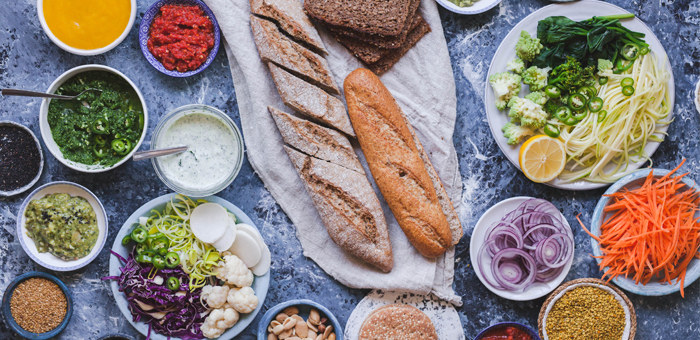How to Eat 30 + Plant Foods a Week

Findings from The American Gut Project show that eating 30 or more different plant foods a week can help to increase the diversity of organisms in the gut. There is growing evidence that a diverse microbiome confers many health benefits. See blog post on American Gut Project Findings for more information about this.
It’s easy to get stuck in a rut when shopping and cooking meaning the same ingredients get eaten day after day. But, it’s surprisingly easy to branch out and increase the range of foods you are eating. Here are some tips for how to eat over 30 plant foods a week (or maybe even a day!):
Pulses
These include beans, peas and lentils. Eat a different pulse every day. Here’s some ideas:
- chickpeas – for hummous or falafels
- red split lentils – for lentil dahl
- peas – for pea puree – a quick and easy dip
- cannellini beans – add to soup with seasonal vegetables
- sprouted mung beans or green lentils – add to salads or stir fries
- black beans – make a sauce to serve with stir fried vegetables
- mixed beans – make a great salad. Add tomatoes, herbs, lemon, nuts and olive oil for a quick and delicious meal
Grains
There are many different grains and they are available in many different forms. Here are some ideas:
- Buckwheat flour – makes delicious pancakes
- Oats – for muesli or porridge
- Sourdough rye bread – a fermented food with many benefits to gut health
- Millet – cook and mix with tahini and grated carrot. Shape into burgers and fry or bake.
- Buckwheat groats – cook and use as the base of a salad. Add roasted vegetables, toasted nuts and herbs.
- Polenta – made from corn polenta can be eaten hot or allowed to cool and cut into chips or slices and fried.
- Rice – there are many types of rice available with many different uses. Rice can be an accompaniment to curry or dahl, a filling for vine leaves or cabbage leaves or the main event as in risotto or rice pudding.
Fruit and Vegetables
There are hundreds to choose from but aim for a range of colours each day to get a wide range of antioxidants:
- Red – strawberries, raspberries, goji berries, tomatoes, pomegranate, cranberries, watermelon, red currants, red peppers
- Orange – carrots, apricots, squash, sweet potatoes, peaches, papaya, apricots, orange peppers
- Yellow – plums, melons, courgettes, squash, grapefruit, lemons, pineapple, yellow peppers,
- Green – lettuce, rocket, kale, broccoli, brussel sprouts, cabbage, spinach, chard, fennel, celery
- Blue/purple – blueberries, blackberries, auberinges, red cabbage, beetroot, grapes, blackcurrants, red onions, plums
- White or cream – cauliflower, bananas, white currants, mushrooms, parnsips, turnips, onions
Nuts and Seeds
Can be eaten raw, soaked, or lightly roasted. Nuts and seeds are extremely versatile:
- Sprinkle nuts and seeds onto salads or cooked foods
- Use almond flour or coconut flour in baked goods
- Nut and seed butters are delicious spread on toast, oat cakes or pitta breads
- Add nut and seed butters to dips or sauces to add richness and depth
- Use creamed coconut instead of cream in sauces, curries and desserts
- Make a trail mix with nuts, seeds, dried fruit and toasted coconut
- Add nuts and seeds to muesli for added nutrition, texture and flavour
- Make cashew cream by blending soaked cashew nuts with orange juice and the seeds from a vanilla pod.
- Add hemp or pumpkin seed protein powder to smoothies
- Use nut and seed oils in salad dressings
There are many to choose from: almonds, hazelnuts, walnuts, pecans, cashews, sunflower seeds, pumpkin seeds, flax seeds, chia seeds, hemp seeds…
There are many more plant foods to choose from including sea vegetables, herbs and spices. For 3 recipes that contain over 30 plant foods between them see blog post on 3 Meals, 30 Foods!